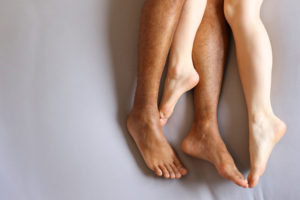Diagnosing And Treating Premature Ejaculation
What is premature ejaculation?
Premature ejaculation (PE) is the most common condition affecting male sexual function.
In 2008, experts appointed by the International Society for Sexual Medicine agreed that three factors are involved in the definition of PE: timing, a sense that the man does not have control over ejaculation, and distress for the couple.
There is no set time when a man should ejaculate during sex. But it is probably too soon if you have an orgasm before intercourse or less than a minute after you start. It is a problem because when you ejaculate you lose your erection and cannot continue having sex.
PE causes a big impact in a man’s sex life which results in discontentment of a man’s partner during sexual intercourse and could lead to serious breakups. Also, PE causes mental health conditions like anxiety and distress to a man after coming too quickly or reaching orgasm easily with no control during sexual intercourse.
The specific cause of this condition is not known yet. Some studies show that the cause of PE is very complex which may involve both biological and psychological.

Clinical characteristics of PE
The diagnosis of PE is made considering the sexual history of the patient.
Most of the men with PE are reluctant and unlikely to request treatment out of embarrassment or shame and when they seek medical attention, many of them have waited years before doing so.
Another roadblock to diagnosis is that clinicians may not be able to rely on the accuracy or completeness of a man’s testimony of his ejaculatory behaviour.
Discrepancies also exist between the man and his partner’s reports of the man’s ejaculatory behaviour. For instance, women have been found to report shorter ejaculatory latency times than their male partner reported.
Thus, the partner’s report of the man’s ejaculatory behaviour might serve as an informative tool for clinicians.
Prevalence of PE
The prevalence of PE varies according to the definition and is difficult to assess in view of many men not wanting to seek help or even discuss the problem.
The aetiology of, and risk factors for PE are unknown, but it is important to distinguish PE from erectile dysfunction; if erectile dysfunction exists, it should be treated before or at the same time as PE.
The prevalence of PE is not related to age and ranges from 3-30%.
Results of studies that assessed the prevalence of PE and erectile dysfunction in single population support the view that PE is more common than erectile dysfunction. An approximately 30% prevalence of PE versus a 10% prevalence of erectile dysfunction was reported. However, awareness of erectile dysfunction is greater due to its more precise definition, standard diagnostic criteria, and established and vigorously promoted medical therapy.
PE effect on culture and ethnicity
Results of an automated telephone self-interview survey of 1,320 men 40 years or older suggest that different racial/ethnic groups may define PE differently and/or differ in the self-reported prevalence of PE. The percent of white, black and Hispanic men who reported “always/almost always” or “usually” experiencing PE in the previous 3 months was 16%, 21% and 29%, respectively. The corresponding percent of men who “always/almost always” or “usually” ejaculated before penetration were 3%, 9% and 16%.
PE classification
The International Society for Sexual Medicine (ISSM) classifies PE in two ways. Lifelong PE is ejaculation that occurs before or within one minute of penetration, starting with the man’s first sexual experience. Men with acquired PE ejaculate within approximately three minutes and had normal ejaculation at one time.
Information to write down before going to your doctor
- Pre-appointment restrictions. When you make your appointment, ask if there are any restrictions you need to follow in the time leading up to your visit.
- Symptoms. How often do you ejaculate before you or your partner would wish? How long after you begin having intercourse do you typically ejaculate?
- Sexual history. Think back on your relationships and sexual encounters since you became sexually active. Have you had problems with PE before?
- Medical history. Write down any other medical conditions with which you have been diagnosed, including mental health conditions. Also note the names and strengths of all medications you are currently taking or have recently taken, including prescription and over-the-counter drugs.
- Questions to ask your doctor. Write down questions in advance to make the most of your time with your doctor.
How is PE diagnosed?
Most often, your health care provider will diagnose PE after a physical exam and talking with you. If you have both PE and trouble getting or maintaining an erection, your doctor might order blood tests to check your male hormone (testosterone) levels or other tests.
In some cases, your doctor might suggest that you go to a urologist or a mental health professional who specializes in sexual dysfunction.
Some questions he or she may ask are:
- How often does PE happen?
- How long have you had this problem?
- Does this happen with just one partner or every partner?
- Does PE happen at every sex attempt?
- What type of sexual activity (i.e., foreplay, masturbation, intercourse, use of visual cues, etc.) do you engage in and how often?
- How has PE affected your sexual activity?
- How are your personal relationships?
- Is there anything that makes PE worse or better (i.e., drugs, alcohol, etc.)?
Laboratory testing is only needed if your health care provider finds something during your physical examination.

How can PE be treated?
The most commonly used treatment for PE is the oral administration of dapoxetine.
Common treatment options for PE include behavioural techniques, topical anaesthetics, medications and counselling. Keep in mind that it might take time to find the treatment or combination of treatments that will work for you. Behavioural treatment plus drug therapy might be the most effective course.
Psychological Therapy
Therapy is a way to address the negative feelings and emotions that lead to problems with sexual relationships. Psychological therapy can be used as the only treatment, or it may be used along with medical or behavioural therapy. The goal of therapy is to learn the source of problems and find solutions that may end PE. It can also help couples learn to grow closer. Psychological therapy can help you become less nervous about sexual performance. It can also give you greater sexual confidence and understanding to improve your partner’s satisfaction.
Behavioural Therapy
Behavioural therapy uses exercises to help build a tolerance to delay ejaculation. The goal is to help you train your body away from PE. Examples include the squeeze method and the stop-start method. Exercises work well, but they may not be a lasting answer. They depend upon your partner’s help, which is not always possible.
The pause-squeeze technique. Your doctor might instruct you and your partner in the use of a method called the pause-squeeze technique.
This method works as follows:
- Begin sexual activity as usual, including stimulation of the penis, until you feel almost ready to ejaculate.
- Have your partner squeeze the end of your penis, at the point where the head (glans) joins the shaft, and maintain the squeeze for several seconds, until the urge to ejaculate passes.
- Have your partner repeat the squeeze process as necessary.
By repeating as many times as necessary, you can reach the point of entering your partner without ejaculating. After some practice sessions, the feeling of knowing how to delay ejaculation might become a habit that no longer requires the pause-squeeze technique.
If the pause-squeeze technique causes pain or discomfort, another technique is to stop sexual stimulation just prior to ejaculation, wait until the level of arousal has diminished and then start again. This approach is known as the stop-start technique.7
Medical Therapy
Dapoxetine, a selective serotonin reuptake inhibitor (SSRI), is the only oral medication developed to treat PE. It is approved in 60 countries.
Two types of medications are commonly prescribed to treat PE:
- Topical anaesthetics (such as lidocaine) are applied directly to the penis before sexual activity. These drugs work by reducing the sensitivity of the penis enough so that a man does not ejaculate too quickly but does not miss out on sexual pleasure either.
- Oral serotonergic drugs work on nerve signalling in the brain and nervous system to delay ejaculation.
You should always take PE medications with the guidance of a healthcare professional.
What is Priligy?
Priligy contains an active substance called „dapoxetine”. This belongs to a group of medicines called selective serotonin reuptake inhibitors. Priligy may also be known as a urological medicine.
Priligy was introduced first as an antidepressant drug, but because of its fast-acting effect, it was realized that it is a good treatment for PE. There are several drugs used as antidepressants, but most people are very much excited and interested about the wonderful effects provided by Priligy, in fact, it is the most best-selling drugs in the market for PE.
How do I know if I need Priligy?
A man suffering from PE usually ejaculates within 2 minutes of his penis entering his partner. Priligy should be used only if you are incapable of expanding this length of time and it is causing serious problems for your sexual relationship.
A study published on Wiley Online Library also provides results of a recent survey that was conducted among sex therapists. Results linked the amount of time it takes for ejaculation to occur to the satisfaction level of the partner.
- Ejaculating within two minutes were found to be “too short”;
- Ejaculating within three to seven minutes were found to be “adequate”;
- Ejaculating within seven to thirteen minutes were found to be “desirable”;
- Ejaculating within ten to thirty minutes were found to be “too long”.
Also, Priligy is the appropriate medication for you if you have a history of PE over the past 6 months in most of the intercourse attempts and marked personal distress or interpersonal difficulty because of PE.
How should I take Priligy?
Priligy is indicated for the treatment of PE in adult men aged 18 to 64 years.
- The recommended dose is 30 mg. If the effect of 30 mg is insufficient and the side effects are acceptable, the dose may be increased to the maximum recommended dose of 60 mg;
- You should take Priligy 1 to 3 hours before sexual activity. It is important to know that you should not take it more than once every 24 hours or every day;
- Swallow the tablets whole to avoid a bitter taste, with at least one full glass of water. This may help lower your chance of fainting. Priligy can be taken with or without food;
- Discuss your treatment with your doctor after the first 4 weeks or after six doses to see whether you should continue treatment.
Effectiveness of Priligy
The main evidence for the effectiveness of Priligy can be found in a large research review conducted by Dr Chris G. McMahon in 2012. He reviewed five different major studies which involved over 6000 men in total. His main findings were:
- For men who last an average of 0.9 minutes, a 30 mg dose increased that to 3.1 minutes;
- A 60 mg dose increased it to 3.6 minutes.
So, it appears that on average Priligy does increase the duration of time by a couple of minutes on average.
It is important to note that it cannot permanently cure PE – you must take it every time you have sex.
Consider that:
- PE is not a sickness or disease and even the most sexually active of men can suffer from it;
- Substances such as wine, beer and certain pills and drugs can lower inhibitions and heighten sexual pleasure-but abuse of them can lead to erectile dysfunction, the inability to orgasm and PE itself;
- Lack of sleep leads to low serotonin levels in the brain, which triggers your body to ejaculate more rapidly;
- Approximately 1 in 3 men suffer from PE at some time in their lives.
Overdosage
There have been no reports of overdose during clinical trials. There were no unexpected adverse events in a clinical pharmacology study of Priligy with daily doses up to 240 mg (two 120 mg doses given 3 hours apart). In general, symptoms of overdose with SSRIs include serotonin-mediated adverse reactions such as somnolence, gastrointestinal disturbances such as nausea and vomiting, tachycardia, tremor, agitation and dizziness. In cases of overdose, standard supportive measures should be adopted as required.
Contraindications
Priligy is contraindicated with:
- Hypersensitivity to the active substance.
- Significant pathological cardiac conditions such as:
- Heart failure
- Conduction abnormalities such as atrioventricular block or sick sinus syndrome.
- Significant ischemic heart disease.
- Significant valvular disease.
- A history of syncope.
- A history of mania or severe depression.
- Concomitant treatment with monoamine oxidase inhibitors (MAOIs), or within 14 days of discontinuing treatment with an MAOI. Similarly, an MAOI should not be administered within 7 days after Priligy has been discontinued.
- Concomitant treatment with thioridazine, or within 14 days of discontinuing treatment with thioridazine. Similarly, thioridazine should not be administered within 7 days after Priligy has been discontinued.
- Concomitant treatment with serotonin reuptake inhibitors (SSRIs), serotonin−norepinephrine reuptake inhibitors (SNRIs), tricyclic antidepressants (TCAs)] or other medicinal/herbal products with serotonergic effects. Concomitant treatment of potent CYP3A4 inhibitors such as ketoconazole, itraconazole, ritonavir, saquinavir, telithromycin, nefazodone, nelfinavir, atazanavir, etc.
- Moderate and severe hepatic impairment.

Side effects
The following adverse drug reactions were reported during Phase 3 clinical trials most commonly and were dose-related: nausea (11.0% and 22.2% in 30 mg and 60 mg prn dapoxetine groups, respectively), dizziness (5.8% and 10.9%), headache (5.6% and 8.8%), diarrhoea (3.5% and 6.9%), insomnia (2.1% and 3.9%) and fatigue (2.0% and 4.1%). The most common adverse events leading to discontinuation were nausea (2.2% of Priligy−treated subjects) and dizziness (1.2% of Priligy−treated subjects).
Key Points:
- PE is a common sexual dysfunction and is associated with negative psychological consequences that may affect the quality of life, partner relationships, self-esteem and self-confidence, and can act as an obstacle to single men forming new partner relationships.
- The evidence-based ISSM definition of lifelong PE should form the basis of the office diagnosis of the condition.
- There is limited evidence suggesting that lifelong PE has a genetic basis and acquired PE is most often due to sexual performance anxiety, psychological or relationship problems and/or erectile dysfunction.
- Oral SSRIs, clomipramine and topical anaesthetics are effective and safe in the treatment of PE (off-label use except for one topical anaesthetic preparation).
- Psychosexual cognitive behavioural therapy has a limited role as a first-line treatment for PE but has an important role as an adjunct to pharmacotherapy, especially in men with acquired PE related to sexual performance anxiety.
- Men with acquired PE secondary to comorbid erectile dysfunction, hyperthyroidism, chronic lower urogenital infection, prostatodynia or chronic pelvic pain syndrome should receive aetiology-specific treatment alone or in combination with an SSRI or clomipramine.
References
- https://www.issm.info/sexual-health-qa/what-is premature ejaculation/?ref_condition=premature-ejaculation;
- https://www.webmd.com/men/what-is-premature-ejaculation#1;
- Godpodinoff ML. Premature ejaculation: clinical subgroups and aetiology. J Sex Marital Ther 1989; 15: 130–134. DOI: 10.1080/00926238908403817;
- Rowland DL, Strassberg DS, de Gouveia Brazao CA, Slob AK. Ejaculatory latency and control in men with premature ejaculation: an analysis across sexual activities using multiple sources of information. J Psychosom Res 2000; 48: 69–77. PubMed PMID: 10750632;
- Hatzimouratidis K, Amar E, Eardley I, Giuliano F, Hatzichristou D, Montorsi F, Vardi Y, Wespes E; European Association of Urology. Guidelines on male sexual dysfunction: erectile dysfunction and premature ejaculation. Eur Urol 2010; PubMed PMID: 20189712; DOI: 10.1016/j.eururo.2010.02.020;
- Althof SE. Prevalence, Characteristics and Implications of Premature Ejaculation/Rapid Ejaculation. J Urol. 2006 Mar;175(3 Pt 1):842-8; PubMed PMID: 16469562; DOI: 10.1016/S0022-5347(05)00341-1;
- https://www.urologyhealth.org/urologic-conditions/premature-ejaculation/treatment;
- http://www.ema.europa.eu/docs/en_GB/document_library/Referrals_document/Priligy_29/WC500124577.pdf;
- Chris G. McMahon. Efficacy of Dapoxetine in the Treatment of Premature Ejaculation.
- Clin Med Insights Reprod Health. 2011; 5: 25–39; PMCID: PMC3888071; PubMed PMID: 24453509; DOI: 10.4137/CMRH.S7337;
- https://www.medicines.org.uk/emc/product/1269/smpc;
- https://medicinetoday.com.au/2010/march/feature-article/diagnosing-and-managing-premature-ejaculation.

